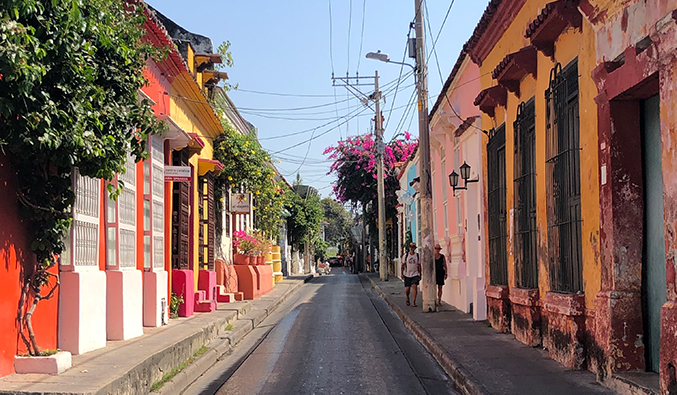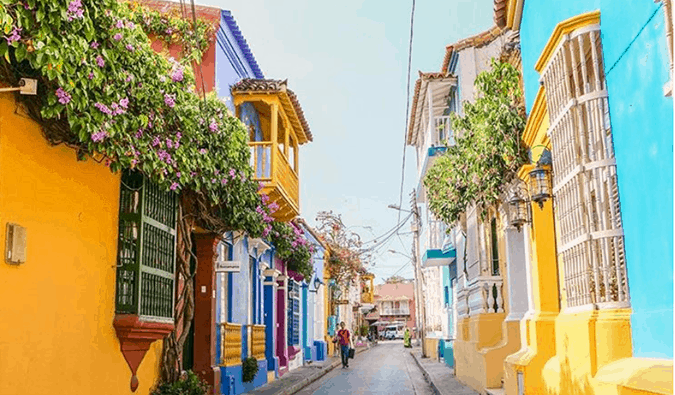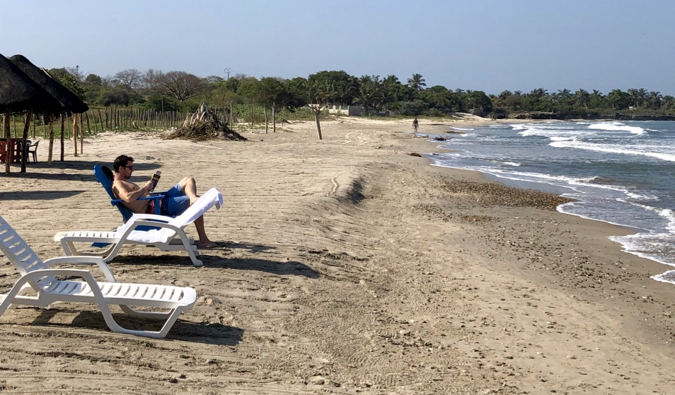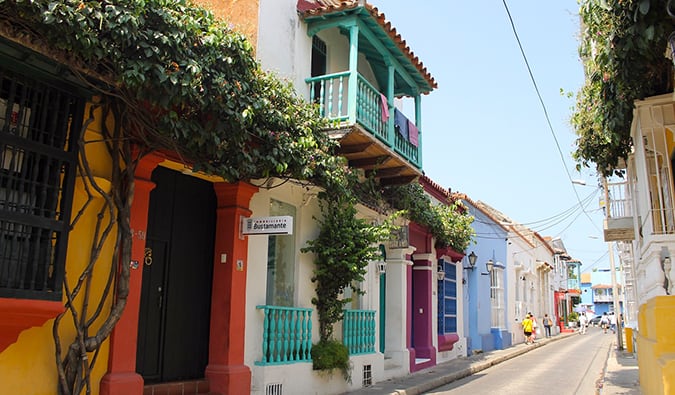
Posted: 3/12/2019 | March 12th, 2019
During the narco heydays, Cartagena was considered the only “safe” spot in Colombia for tourists. It was where foreigners vacationed, cruise ships docked, and rich Colombians built their vacation homes.
Today, this colorful colonial city remains one of the most popular destinations for tourists and Colombians alike. Rich Colombians — and now foreigners — still build vacation homes here, cruise ships still dock, and the influx of tourists has grown with an increasing number of direct flights from North America and Europe.
Out of all the stops on my Colombian tour, Cartagena was the place I was least excited about.
As one of the best-preserved and historic cities in Colombia, I knew I would love its narrow colonial streets, ancient walls, grand plazas, and Spanish-style houses with their giant doors and wooden terraces, not to mention the restaurants whose tables spilled into busy plazas.
But I was not so eager to be in such a touristy, crowded city for five long days. A friend was flying down for a quick vacation and he was not keen to go elsewhere on a long bus. I would be stuck in this tiny, tourist town.
Cartagena turned out to be everything I thought it would be.

It had the kind of heat and humidity that melted you in place, it was very expensive, and it was filled with throngs from cruises, tours, bachelor and bachelorette parties, and gringos trying to score drugs (and shady streetside pushers happy to oblige).
Throw in packed streets and too few “tourist” activities and I was ready to get out of there as soon as I had arrived. (Seriously. After a couple of museums, a walking tour, and a visit to a beach or two, you’ve pretty much seen the city.)
But, when it did come time to leave, I found myself downright crestfallen.
I had grown to really love Cartagena.
In the midst of all those touts and tourists, I found an architecturally beautiful and vibrant city. A place on whose edges the crowds disperse and lovely little Colombian cafés appear. A city with cutting-edge restaurants, lively music, town squares full of life, and funky bars.
Early in the morning, before the heat of the day drove me inside and the cruise ships let their armies loose, I’d wander the empty streets of the old town, taking copious pictures as the light dangled perfectly between streets. I got my tea and breakfast at the same shops. Waved hello to locals sitting in the parks. Busy Cartagena is a quiet little town at 8am.
In Getsemani, the backpacker area, I found colorful homes, squares filled with street vendors, cheap eateries, and heaving bars. I’d sit at night with my street food watching bands and street performers, including a duo who flawlessly reenacted “Thriller.”
And, in Bocagrande, a Miami-style neighborhood for the rich and famous, I saw how the well-to-do lived, enjoyed some of the better beaches in the area, and strolled along its long promenade.
My friend and I dove into the city’s fabulous gastronomy scene and gorged on delicious ceviche, empanadas, brick-oven pizza, and traditional Colombian food. The food scene here was one of the best in Colombia. (It was really impressive for such a small city. See the bottom of the post for recommendations.)
In beautiful colors that must be mandated by the government, the vibrantly painted buildings and heavy doors with shapes and designs that could be their own blog gave Cartagena an upbeat feel to it.
Spending extra time doing nothing allowed me to linger a bit longer, explore some hole-in-the-wall shops, sit along squares with a beer, and head over to the least touristy beach possible:

(It was me, my friend Ryan, and some kids on a boogie board)
I had fallen in love with Cartagena because there wasn’t much to do there. I couldn’t fill my days with activities. All I could was just chill and relax.
Sure, the crowds couldn’t be ignored since I always had to jostle for space, but as I drank tea, ate well, strolled the picturesque city walls, and made a local friend who took me out with his family and friends, I thought about how there’s always another side to a place.
Whenever you visit somewhere, there always seems to be an area that most travelers never go past, as if an invisible barrier keeps them from going just one step farther.
But it’s in that extra step that we find the “local,” non-touristy parts of town, away from the crowds.
So too is there a time barrier. As travelers, we often swoop in, take photos, see the attractions, eat the food, and leave claiming some sort of deeper knowledge. We see a snapshot of life and create a complete history from that one image.
I heard it from many people before I visited:
“Cartagena is an overpriced, touristy city. It’s good for just a few days. See it, leave it.”
On one level, that is true. It is overpriced. It is touristy. And, if you’re in a rush, you don’t need a lot of time to check off the boxes.

But, beneath the layers, like all cities, there was a non-touristy version of Cartagena.
Like the invisible line that keeps tourists in their zone, all I had to do was wait out the invisible time barrier to see it. Suddenly, the switch was flipped, the doors opened, and Cartagena revealed some of its secrets.
Cartagena is not about seeing the sights.
And, when I stopped trying to be a tourist looking for sights and accepted for the city as it was, Cartagena became a place I couldn’t get enough of.
If I had only stayed a few days, I probably would have felt about the city the way everyone else did.
But when you stop putting cities into the pre-framed images you have for them, they tend to surprise. Those extra days just allowed me to enjoy the city for what it was: a place to relax, eat, and slow down.
Recomennded places to eat
- Carmen – Very, very high-end gastronomy. This place not cheap but it was the best meal I had in Colombia. I can’t recommend it enough. Come for lunch when you won’t need a reservation.
- La Mulata – A nice little cafe for lunch.
- Demente – Awesome pizza and cocktails in a rustic setting.
- Cafe Stepping Stone – Aussie style cafe. They do a good breakfast and brunch.
- El Punto – Across the street from Cafe Stepping Stone, this hole in the wall restaurant serves traditional Colombian food at dirt cheap prices.
- Don Juan – Another high-end dinner restaurant. If you’re looking for something classy that serves good, solid food, check this place out.
- La Cevichería – Bourdain put this place on the map as having the best ceviche in the city. I don’t know if it’s true but everything here was top notch. Come early as it gets super busy the second they open.
Book Your Trip to Cartagena: Logistical Tips and Tricks
Book Your Flight
Find a cheap flight by using Skyscanner or Momondo. They are my two favorite search engines because they search websites and airlines around the globe so you always know no stone is left unturned.
Book Your Accommodation
You can book your hostel with Hostelworld. If you want to stay somewhere other than a hostel, use Booking.com as they consistently return the cheapest rates for guesthouses and cheap hotels. I use them all the time.
Don’t Forget Travel Insurance
Travel insurance will protect you against illness, injury, theft, and cancellations. It’s comprehensive protection in case anything goes wrong. I never go on a trip without it as I’ve had to use it many times in the past. I’ve been using World Nomads for ten years. My favorite companies that offer the best service and value are:
- World Nomads (for everyone below 70)
- Insure My Trip (for those over 70)
Looking for the best companies to save money with?
Check out my resource page for the best companies to use when you travel! I list all the ones I use to save money when I travel – and I think will help you too!
Looking for more information on visiting Colombia?
Check out my in-depth destination guide to Colombia with more tips on what to see, do, costs, ways to save, and much, much more!
The post Cartagena: A City of Color, Tourists, and Food appeared first on Nomadic Matt's Travel Site.